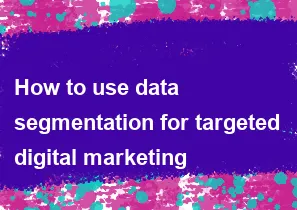How to use data segmentation for targeted digital marketing

Data segmentation is a crucial strategy in targeted digital marketing that involves dividing a larger target audience into smaller, more specific groups based on certain characteristics or behaviors. This allows marketers to tailor their messages and campaigns to each segment's unique needs and preferences. Here's a step-by-step guide on how to use data segmentation for targeted digital marketing:
Define Your Goals: Clearly outline your marketing objectives. Understanding your goals will help you identify the specific criteria for segmentation.
Collect Relevant Data: Gather data from various sources, including your website, social media, customer surveys, and any other relevant touchpoints. Data could include demographics, psychographics, behavior patterns, purchase history, and engagement metrics.
Identify Segmentation Criteria: Determine the criteria you'll use to segment your audience. Common segmentation criteria include:
- Demographics: Age, gender, income, education, etc.
- Psychographics: Interests, values, attitudes, lifestyle.
- Behavior: Purchase history, online interactions, engagement level.
- Geographic: Location, climate, culture.
Segmentation Analysis: Analyze your data to identify patterns and commonalities within your target audience. Look for trends and insights that can help you create meaningful segments.
Create Customer Personas: Develop detailed customer personas for each segment. Personas are fictional characters representing different segments, embodying the key characteristics of each group.
Targeted Messaging: Craft personalized and targeted messages for each segment. Consider the unique needs, preferences, and pain points of each persona when creating your content.
Choose the Right Channels: Identify the channels your target segments frequent the most. This could include social media platforms, email, search engines, or specific websites. Tailor your marketing efforts to these channels.
Implement Personalization: Utilize personalization techniques in your marketing materials, such as personalized emails, product recommendations, or dynamic content on your website. Personalization increases engagement and conversion rates.
Optimize Ad Campaigns: If you're running digital advertising campaigns, optimize them for each segment. This may involve creating separate ad sets for different segments, using custom audiences, and adjusting your bidding strategy based on segment priorities.
Measure and Analyze Results: Regularly monitor and analyze the performance of your campaigns for each segment. Evaluate metrics such as conversion rates, click-through rates, and return on investment (ROI). Use these insights to refine your future segmentation strategies.
Iterate and Refine: Based on the results, continuously refine your segmentation strategy. As customer behaviors and market dynamics change, your segmentation approach should evolve to remain effective.
By implementing data segmentation in your digital marketing efforts, you can enhance the relevance of your messages, improve customer engagement, and ultimately drive better results for your business.
-
Popular Post
- How to optimize for Google's About This Result feature for local businesses
- How to implement multi-language support in an Express.js application
- How to handle and optimize for changes in mobile search behavior
- How to handle CORS in a Node.js application
- How to use Vue.js with a UI framework (e.g., Vuetify, Element UI)
- How to configure Laravel Telescope for monitoring and profiling API requests
- How to create a command-line tool using the Commander.js library in Node.js
- How to implement code splitting in a React.js application
- How to use the AWS SDK for Node.js to interact with various AWS services
- How to use the Node.js Stream API for efficient data processing
- How to implement a cookie parser middleware in Node.js
- How to implement WebSockets for real-time communication in React
-
Latest Post
- How to implement a dynamic form with dynamic field styling based on user input in Next.js
- How to create a custom hook for handling user interactions with the browser's device motion in Next.js
- How to create a custom hook for handling user interactions with the browser's battery status in Next.js
- How to implement a dynamic form with dynamic field visibility based on user input in Next.js
- How to implement a dynamic form with real-time collaboration features in Next.js
- How to create a custom hook for handling user interactions with the browser's media devices in Next.js
- How to use the useSWRInfinite hook for paginating data with a custom loading indicator in Next.js
- How to create a custom hook for handling user interactions with the browser's network status in Next.js
- How to create a custom hook for handling user interactions with the browser's location in Next.js
- How to implement a dynamic form with multi-language support in Next.js
- How to create a custom hook for handling user interactions with the browser's ambient light sensor in Next.js
- How to use the useHover hook for creating interactive image zoom effects in Next.js